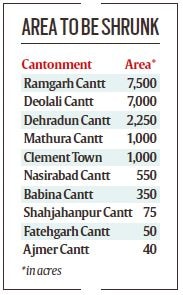IN THE first such largescale exercise, the Centre is learnt to have decided to shrink the land under the jurisdiction of 10 key cantonment boards across five states, and put them under the state local bodies instead.

The affected areas, adding up to about 20,000 acres — almost half of the 10 cantonment boards’ combined area of 45,000 acres — includes mostly private properties and land housing municipal amenities like water and sewerage pipelines, said the source. While these areas will be placed under the jurisdiction of the state local bodies, the ownership of land owned by the Armed Forces and central government will remain unchanged. The land given on lease to private institutions and organisations will remain with the central government, said the source.
Story continues below this ad
In separate gazette notifications on the 10 cantonment boards issued on March 5, the Ministry of Defence said: “In exercise of the powers conferred by sub-section (1) of section 4 of the Cantonments Act, 2006 (41 of 2006), the Central Government, after consulting the State Government… and Cantonment Board…, hereby declares its intention to exclude certain areas of the said cantonment… and the merger of such areas with state local body.”
“Any objection to the above declaration by any inhabitant of a cantonment may be submitted to the Central Government through the General Officer Commanding-in-Chief (GOC)… within eight weeks from the date of publication of this notification,” it said.
No objections have been received so far, and once the eight-week deadline is over (April-end), a final notification will be published after taking the opinions of the concerned state governments into consideration, said the source.

The 10 affected cantonment boards are: Ramgarh Cantonment in Jharkhand (7,500 acres); Deolali Cantonment in Maharashtra (7,000 acres); Dehradun Cantonment (2,250 acres) and Clement Town Cantonment (1,000 acres) in Uttarakhand; Mathura Cantonment (1,000 acres), Shahjahanpur Cantonment (75 acres), Babina Cantonment (350 acres), and Fatehgarh Cantonment (50 acres) in Uttar Pradesh; and Nasirabad Cantonment (550 acres) and Ajmer Cantonment (40 acres) in Rajasthan.
Story continues below this ad
Of these, only Babina Cantonment and Ajmer Cantonment were established after independence. In fact, of the 61 cantonment boards in the country, only six were established after independence — Jammu in 1954, Badami Bagh in 1954, Morar in 1956, Dehu Road in 1958, Babina in 1959, and Ajmer in 1962.
At present, cantonment boards provide civic services like trade licence, birth and death certificates, water supply, sewerage connections, and building plan approvals to those living within their jurisdiction. But unlike municipalities, the cantonment boards are run by Armed Forces personnel, Defence Ministry officials, state government officials, and a few elected representatives — a civic administration system that dates back to pre-independence era.
“The cantonment boards are managed by GOCs, Indian Defence Estates Service (IDES) officers, state bureaucrats, and a few elected members,” said the source. “It is not the job of the Armed Forces and Indian Defence Estates Service officers to run municipalities. Therefore, a need was felt to exclude certain areas from the limits of the cantonment boards and merge them with the elected urban local bodies,” the source said.
This is the first time that an excision of this scale is being undertaken. In the last seven decades, only partial excisions were undertaken in five cantonment boards — Varanasi, Ahmedabad, Agra, Jhansi and Ambala in the 1950s and 1960s. The last such exercise was carried out in 1986, when some areas of Khasyol cantonment board in Dharmshala, in Himachal Pradesh, were removed. The Khasyol cantonment was completely denotified in April last year, and it is just a military station now.
Story continues below this ad
A cantonment board is a civic administration body notified under the Cantonments Act, 2006, and functions like a municipal body. While it is under the administrative control of the Ministry of Defence, it can include civilian inhabitants.
On the other hand, a military station is built solely for the Armed Forces, and does not include civilian inhabitants. Under the administration of the Armed Forces, the Cantonment Act does not apply to military stations.










